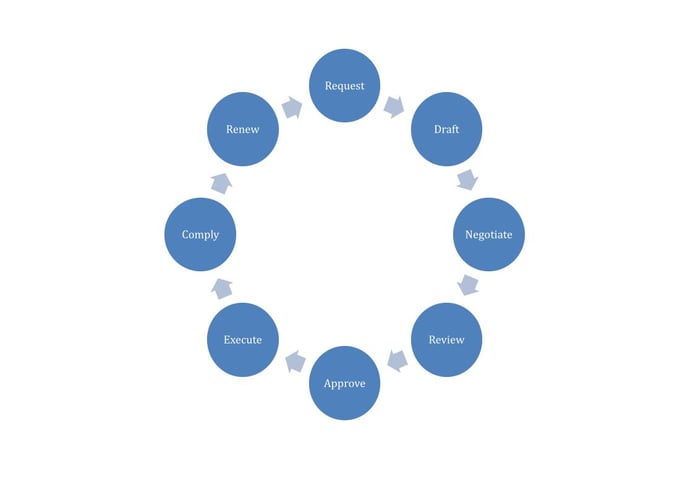Corporate legal departments are facing a slew of challenges in the current market. In-house lawyers reportedly work about 51 hours per week on average, which can have a marked impact on their mental and physical well-being. That’s why legal operations best practices in 2022 need to center on the employee experience. By providing a supportive, transparent, and streamlined working environment, legal teams can cut down on burnout and improve operations across the board.
.jpg?width=804&name=shutterstock_744719272%20(2).jpg)
5 Legal Operations Best Practices
Legal operations best practices in 2022 should focalize existing workflows while underscoring simplicity to address current market challenges. It’s about ensuring the right people have the right information and authority they need to make informed business decisions. Meanwhile, mundane tasks are minimized. Specifically, businesses should focus on the following 5 key areas of legal ops.
- Hierarchy
- Collaboration
- Contract lifecycle
- Improvements
- Tools
A focus on these five areas will help companies streamline their processes and minimize the burden on legal operations staff. Here’s a more in-depth look at each approach.
1. Build a three-pronged hierarchy
Legal operations can’t be treated as a single entity with one goal and a hierarchy structure built under it. There are three smaller departments within its structure.
Services
|
Finance
|
Technology
|
|
These are the lawyers and support staff that provide legal services, such as creating, negotiating, and managing contracts for every department of the business.
|
Legal ops finance handles funding, authority for negotiation and settling deals, and full accounting support relating to compliance and reporting.
|
Tech departments need their own suite of technology tools as well as software for managing workflows and collaborating with others.
|
A legal ops department treated as a monolith may have a lawyer at the helm, but it could be lacking operations, finance, or technology experience. Breaking down the hierarchy of these departments helps put the right people in place to lead teams.
2. Support cross-functional collaboration
Information silos are a challenge for many businesses, especially when dealing with sensitive legal matters like contracts. Some information has to be kept separately to ensure confidentiality while other details need to be shared across departments to support process flow.
One important component here is standardization. An AI Digital Playbook can apply a legal department's standardized language, negotiating requirements, and crucial clauses to every contract draft. This single source of truth allows the department to collaborate more effectively as the standards are known and documented.
3. Map the contract lifecycle
Contract lifecycle stages can differ based on the needs of the enterprise. A typical life cycle follows eight steps as shown in the diagram below:
- Request: The need for the contract is established
- Draft: A first draft is created
- Negotiate: The parties pass the draft back and forth, marking it up
- Review: Lawyers review the contract for accuracy
- Approve: Parties sign the contract
- Execute: The contract goes into effect
- Comply: Parties complete their required tasks
- Renew: The contract expires or is renewed
While these steps seem to feed into each other, they’re rarely completed as a single progressive process. Lawyers may go through the drafting, negotiation, and review phases several times. This is known as the pre-execution contract stage and is the lengthiest part of the process. It’s also where legal teams can find the most opportunity for improvement.
4. Review potential improvements
Contract lifecycle management is such a major part of legal operations that just about any improvement in this area can have a significant impact on the entire business. After mapping out the contract lifecycle, a company may discover a few common areas to target.
One is the time a lawyer spends on small tasks. In one study on lawyer time allocation, it was found that 48% of their time was spent on mundane administrative tasks. The ability to move many of these tasks off their plates could improve legal operations flow and work-life balance. By identifying where their biggest time-wasters occur, legal teams can consider potential solutions to minimize them.
Another common issue is non-standardized processes. Different lawyers may take different approaches when drafting and negotiating the same type of contracts. That makes it very hard to control the process on a large scale, which is often needed in legal operations.
5. Choose the right tools and technology
By identifying areas of opportunity, businesses can begin to look at the tools and support they may need to eliminate workflow bottlenecks. Automated contract review is a popular option as it tackles more than a few standard problems in the contract lifecycle.
For example, legal departments can set their own approved language, clauses, and terms for contracts which are subsequently enforced in every draft via an AI Digital Playbook—an automated contract review guide. Rather than having junior-level associates review agreements for accurate clauses and terms, an automated solution can redline it in less than 5 minutes. If necessary, it can also offer revision suggestions for improvement.
In addition, some AI contract review solutions allow for context. Lawyers can add notes to changes and explain why they were made. This improves collaboration and helps overcome department silos which often saturate the contract lifecycle process.
Technology is an integral part of the legal operations best practices of 2022 because it helps legal teams overcome common department challenges. Information silos, administrative work, contract reviews, and other tasks can be controlled through intuitive, AI-powered solutions that get better after every use. Meanwhile, lawyers can spend time on more sophisticated tasks and enjoy better work-life balance.
-1.jpg)
.jpg?width=804&name=shutterstock_744719272%20(2).jpg)
